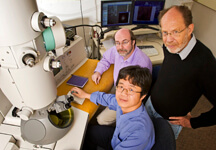
| RELATED INFO |
| * Richard Kuhn |
| * Michael Rossmann |
| * Wen Jiang |

November 17, 2009
New effort probes how two groups of viruses cause disease
WEST LAFAYETTE, Ind. - |
The viruses also pose a potential homeland security threat because they have been used to make biological weapons, said Richard Kuhn, a professor and head of the Department of Biological Sciences at Purdue.
"Viruses within these two groups pose significant risks to large segments of the population, and methods for controlling infection and disease are few," he said. "These are really important human diseases."
One group, called flaviviruses, includes West Nile and dengue. The other group, called alphaviruses, includes eastern equine encephalitis and chikungunya.
"Dengue infects more than 50 million people annually, killing about 24,000 each year, primarily in tropical regions," Kuhn said.
Both types of viruses are transmitted by mosquitoes and sometimes ticks.
"Although these viruses are now mostly restricted to the tropics, as population density increases in cities and there is a greater global movement of people, there is the fear that these viruses are going to gain a greater geographical range," Kuhn said. "There also is the possibility of terrorists using weapons made from these viruses, so a better understanding of their life cycles could lead to ways to defend against attacks."
The work is funded with a two-year $4 million American Recovery and Reinvestment Act grant through the National Institutes of Health's National Institute of Allergy and Infectious Diseases.
The project will involve three Purdue faculty members and two former Purdue researchers who are now at other institutions. From Purdue are Kuhn; Michael Rossmann, the Hanley Distinguished Professor of Biological Sciences; and Wen Jiang, an assistant professor in the Department of Biological Sciences. The two other researchers are Janet L. Smith, professor of life sciences and biological chemistry at the University of Michigan, and Timothy Baker, a professor in the Department of Chemistry and Biochemistry at the University of California, San Diego.
"It's a team of investigators, so instead of having five independent grants, we are working collaboratively on projects that mesh together," Kuhn said.
The work also will involve 12-15 Purdue graduate and undergraduate students, as well as postdoctoral and research scientists.
The researchers will use advanced imaging technologies, including cryoelectron microscopy and X-ray crystallography, along with techniques in biochemistry, molecular biology and genetics, to uncover critical structural details about the viruses.
Both types of viruses have a two-layer outer protein-and-lipid membrane envelope and a genome of RNA, or ribonucleic acid. In alphaviruses, the heads of key proteins protrude outward like spikes, with the tails extending into the virus. The proteins in the flaviviruses lie flat on the surface of the virus' outer shell, which resembles a golf ball's bumpy shape.
"The current understanding of alphavirus and flavivirus life cycles at the molecular level is incomplete because we lack a structural foundation for the viral and host proteins involved in RNA replication, how this genome is packaged, and how the virus is assembled inside the host cells," Kuhn said. "We are interested in their life cycles.
"What do they look like? How do they get into cells? What happens once they do? Then, how do they assemble themselves and exit the host cells?"
Researchers also will probe how antibodies bind to the viruses.
"Using structural information, we can figure out how the antibodies work and which sites they specifically bind to on the outside of the viruses, and those findings may lead to better vaccines and antiviral drugs and a better understanding of how the viruses infect host cells," Kuhn said.
A portion of the new research will be in a modern lab for virus analysis in the Wayne T. and Mary T. Hockmeyer Hall of Structural Biology, which is expected to open by the end of the year.
The lab is located on the first floor of the new $32.9 million, 65,690-square-foot Hockmeyer building, home to Purdue's Markey Center for Structural Biology research group. Hockmeyer Hall is adjacent to Discovery Park at Harrison Street and Martin Jischke Drive and is named for Wayne T. Hockmeyer and his wife, Mary, who provided $5.3 million toward its construction.
The research is an extension of previous work that began in 2002 to establish a comprehensive facility for viral structure and functional studies.
Writer: Emil Venere, 765-494-4709, venere@purdue.edu
Sources: Richard J. Kuhn, 765-494-1164, kuhnr@purdue.edu
Michael Rossmann, 765-494-4911, mgr@indiana.bio.purdue.edu
Wen Jiang, 765-496-8436, jiang12@purdue.edu
Purdue News Service: (765) 494-2096; purduenews@purdue.edu
PHOTO CAPTION:
Purdue University is leading a team of researchers in a federally funded effort aimed ultimately at developing better vaccines and antiviral drugs against two types of disease-causing viruses. The work is led by Richard Kuhn, top left, a professor and head of the Department of Biological Sciences, Michael Rossmann, right standing, the Hanley Distinguished Professor of Biological Sciences, and Wen Jiang, an assistant professor in the Department of Biological Sciences. (Purdue University photo/Andrew Hancock)
A publication-quality photo is available at https://www.purdue.edu/uns/images/+2009/kuhn-viruses.jpg
To the News Service home page
